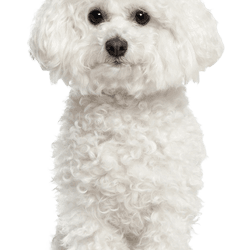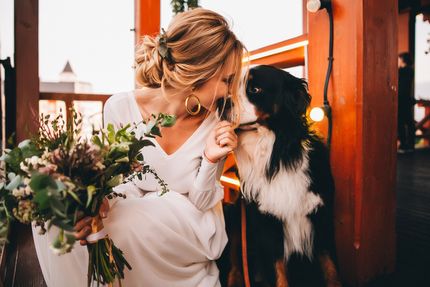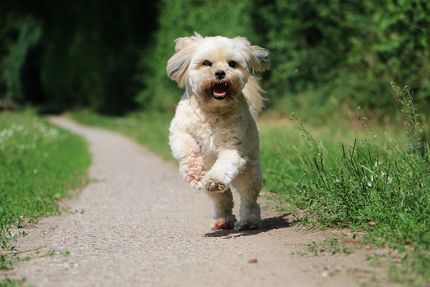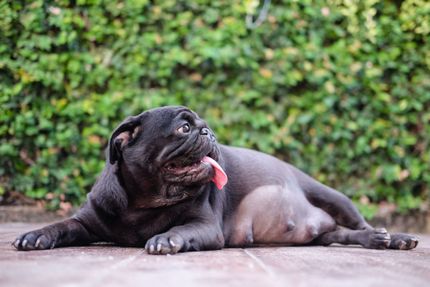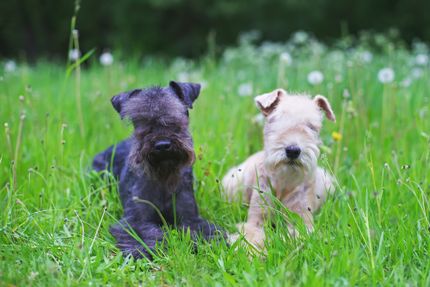Pushon:Bichon Frisé and Pug Mix
Facts & Origin
Pug and Bichon Frisé mix - a hybrid breed
The name Puschon is a mixture of two breed names and comes from the English word for Pug: Pug and Bichon Frisé. This cuddly little mixed breed is the perfect combination of the best features of the Pug and the Bichon Frisé. The Pug-Bichon Frisé mix is a great choice for anyone looking for a small, affectionate companion that is also hypoallergenic.
What are breed characteristics of this mix dog?
The Pug-Bichon Frise mix is a small dog with a compact build. They usually weigh between 6-8 kg and are about 30 cm tall. They have a round head with a short muzzle, and their eyes are large and dark. Their fur is soft and fluffy and can be either white, cream or apricot. They have a black nose and their tail is curly and fluffy.
| Alternate Name | - |
| Origin | France - China |
| Life expectancy | 12 - 15 years |
| Care requirements | low-maintenance |
| Activity level | low |
| FCI group | not recognised |
| AKC group | not recognised |
| KC group | not recognised |
More Bichon Frisé mixes
More Pug mixes
Attitude, character and temperament of the breed
Possible character traits of Pug and Bichon Frisé mix - This is probably his nature
If you're looking for a dog that brings fun and laughter to life, then you can't go wrong with a Pug Bichon Frisé mix. These dogs are known for their outgoing and playful personalities, and they love to be the center of attention. They are also known to be very affectionate and loving. So if you are looking for a cuddle buddy, this is the dog for you.
Pugs and Bichon Frisé are both relatively small breeds, so you can expect the Pug-Bichon Frisé mix to be rather small. They usually weigh between 6-8 kg and are about 30 cm. This makes them the perfect size for city living and also suitable for families with small children.
The Pug-Bichon Frise mix is fairly low maintenance when it comes to grooming. They don't need to be brushed often, although you will want to rid them of loose hair with a soft brush every few days. They should only be bathed when necessary, as excessive bathing can strip their skin of its natural oils.
The Pug-Bichon Frise mix is an intelligent breed that is quick to learn new tricks and commands. However, they can be stubborn at times, so you will need to be patient and consistent when training them. However, with a little time and patience, you can easily teach your Pug Bichon Frise mix everything he needs to know.
If you are looking for a fun-loving, affectionate and easy to care for dog, the Pug-Bichon Frise mix is the perfect breed for you.
Character
Usage


Health and breeding information
What diseases can occur in Pug and Bichon Frisé Mix.
The Pug Bichon Frisé mix breed is known to be a healthy and hardy mixed breed. However, there are some health problems that have been associated with this mixed breed. Health disorders that have been identified in Pug Bichon Frise mixes include obesity, hip dysplasia, patellar luxation, and elbow dysplasia.
Obesity is one of the most common health problems in the Pug-Bichon Frise mix breed. This problem is often caused by overfeeding and lack of exercise. Obesity can lead to other health problems, such as joint problems, respiratory problems, and heart problems.
Hip dysplasia is a condition that affects the hips and can cause pain and lameness. Hip dysplasia is more common in larger breeds, but has also been seen in Pug-Bichon Frise mixes.
Patellar luxation is a condition of the kneecap that can cause pain and lameness. Patellar luxation is more common in smaller breeds, but has also been observed in Pug-Bichon Frise mixes.
Elbow dysplasia is a condition of the elbow that can cause pain and lameness. Elbow dysplasia is more common in larger breeds, but has also been observed in Pug-Bichon Frise mixes.
What does this mixed breed look like?
Pug-Bichon Frisé mixes usually have a soft, medium-length coat that is either black, white or silver. They may also have some brown or tan markings on their face and body.
| Fur length | short |
| Fur | curly - flat coated |
| Ear shape | Floppy Ear - Tilt-ear |
| Tail | fanned out - stubby |
| Anatomy | dainty, massive, square, hefty |
| Size ♀ | 22 - 28 cm |
| Weight ♀ | 3 - 8 kg |
| Size ♂ | 23 - 30 cm |
| Weight ♂ | 3 - 8 kg |
| Suitable For | suitable for allergy sufferers, Children, Beginner, Children, Seniors |
Known Diseases
Eye diseases
Often occur with allergies and intolerances.
Patellar luxation
Patellar luxation is the term used to describe a displacement of the kneecap, which is one of the most common causes of lameness in dogs.
Breathing problems
Dogs with shortened muzzles can often experience respiratory problems.
Denture malocclusions
Malocclusions of the dentition often occur in dogs with short muzzles.
Heart disease
Can occur frequently in dogs and can sometimes be treated with medication.
Hip dysplasia (HD)
The hip dysplasia or hip joint dysplasia of the dog (HD) is a maldevelopment of the hip joint.
Shortness of breath
Difficult breathing can be recognized by the dog's rattling and sometimes accelerated breathing rate.
Overweight
Often, unfortunately, the dogs very much under excess weight. But the dogs themselves are never to blame!
FAQ
-
Pug and Bichon Frise mixes typically reach 9-11 inches tall and weigh between 9 and 16 pounds.
-
Pug and Bichon Frise mixes have a soft, fluffy coat that can be either straight or wavy. They can have a mixture of Pug and Bichon Frise coloring, or they can be solid colored.
-
Pug and Bichon Frise mixes need moderate exercise, and a daily walk or play session should be sufficient. They can live in an apartment as long as they receive enough mental and physical stimulation.
-
The life expectancy of a Pug-Bichon Frise mix is 12-15 years.
-
Pug and Bichon Frise mixes are good with children and other pets if socialized from a young age. They can be shy around strangers. Therefore, introduce them slowly to new people and situations.
Useful Articles
You can find articles that might interest you in the dogbible blog to match your favorite breed.
Visit our magazineto stay up to date on dog trends.
To find out more, view our Privacy Policy
Find here the breed that suits you and find out what character traits it has. Here you can also learn more about the origin, size and weight of your favorite breeds.
Matching your favorite breed, you'll find articles that might interest you on the dogbible dog blog.
Apps for dog owners - these 10 apps you should know about
3 painkillers for the dog: These you must have at home
Dogs at the wedding - here's how you can incorporate your favorite one
